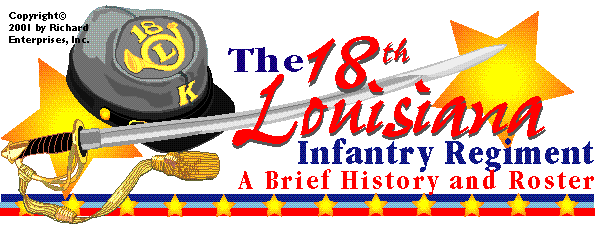


Now we will have a little fun with a generous helping of speculation. The following page is based on research done on a number of web sites that illustrate the history of the Confederate Flag as well as a few books that also give details on the history of the Confederate flag and visits to the Memorial Hall Confederate Museum in New Orleans along with visits/discussions with "living history" reenactment groups. The records of that era are scarce and in some cases no records exist of the flag designs that are depicted below. So, we will have a bit of fun and try to piece together what the evolution of the 18th Louisiana Infantry Regiment battle flag just might look like during it's history from the formation of the 18th Regiment at Camp Moore on 5 October 1861 through it's long history and eventual disbanding at Mansfield on 19 May 1865 as the Consolidated 18th Louisiana Infantry Regiment and Yellow Jacket Battalion.
The following illustration and descriptive information is based on research and some speculation with regards to the evolution of the battle flags carried onto the "fields of honor" by the brave men who became color bearers with this historic Louisiana infantry regiment. A large helping of assistance was obtained from the web sites listed on this page and the book The Flags of the Confederacy, an Illustrated History, by Devereaux D. Cannon, Jr. Should anyone who views this group of flags have any additional information or information to the contrary, please feel free to contact this web master at the e-mail address listed at the bottom of this page. The pages of the 18th Louisiana Infantry Regiment (Volunteers) are under construction and/or revision on a continuing basis. Our ultimate goal is to make sure that the most historical and accurate picture of this Louisiana infantry regiment emerges and is available for all to peruse and portray an accurate image of part of our Southern Heritage. Lest we forget, we honor the men who answered the call to arms and served. We attempt to honor their sacrifices by keeping their memory alive.
Deo Vindice ("If We Do Not Forget")
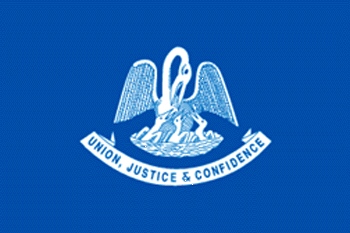
...The first flag carried as a standard by the 18th Louisiana Infantry Regiment would probably have been the Pelican State Flag of Louisiana. Many Confederate units carried state flags in lieu of battle flags because of non-standardization of flags early in the war. Though not documentated (at least none so that this researcher can locate) as being actually carried by the 18th Louisiana, it is a very good speculation that this was the case early on by the regiments being formed at Camp Moore, Louisiana. There are many such flags [50 or more] on display at the Memorial Hall Confederate Museum, in New Orleans. For further details on the history of the Confederate flag, check out the following excellent web sites:
Flags of the Confederacy
also
Confederate Flag History
Louisiana Pelican State Battle Flag (typical)
This photo was submitted by Shaun Riedell, the Great great grandson of William H. Rhody, Pvt., Co. I. The image was taken at the Museum of Weapons and early American History in St. Augustine, Florida. The flag depicted is actually a center section of a captured Louisiana battle flag. It measures approximately 24 x 24 in. It was a common practice to save the center section of a captured battle flag as a trophy of war, and then allow the remainder of the flag to be cut up into small sections and given to the men of the capturing unit. This information was provided by the museum owner/curator, Ms. Donna Lee Walton. Though the regiment is unknown, the flag is typical of that era.The image is hand painted.
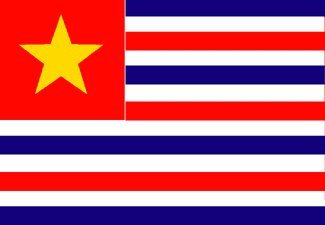
...Louisiana adopted a new flag, called the Flag of Louisiana on February 11, 1861. This flag was adopted by the Louisiana Secession Convention on January 26, 1861 and was adopted in lieu of the "pelican" flag. The new flag which showed a sentimental attachment to the United States and the lone star symbol of sovereignty. The colors chosen were from the states colorful history including colors from the United States, France and Spain.Though not documentated (at least none so that this researcher can locate) as being actually carried by the 18th Louisiana, it is very good speculation that this was the case early on by the regiments being formed at Camp Moore which would have included the 18th Louisiana Infantry Regiment. See The Flags of the Confederacy-An Illustrated History by Devereaux D. Cannon, Jr. For further details on the history of the Confederate flag, check out the following excellent web sites:
Flags of the Confederacy
also
Confederate Flag History
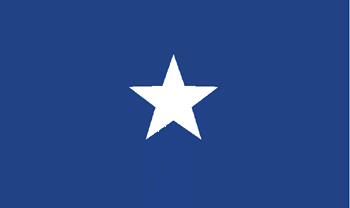
...many of the regiments in the western theatre carried this flag and even though it was not adopted as the official flag, many of the citizens of the South did recognize this as the official flag of the confederacy early on and consequently some regiments did carry this flag as their standard. It was also referred to as the "Lone Star Flag"and was adopted by five southern states in one form or another. This flag was very popular among the average citizens of the Confederacy. For further details on the history of the Confederate flag, check out the following excellent web sites:
Flags of the Confederacy
also
Confederate Flag History

...the first official flag carried as a standard by the 18th Louisiana Infantry Regiment would probably have been the "Stars and Bars" which was recognized as the first official flag of the Confederacy. Though not documentated as being actually carried by the 18th Louisiana, it is a very good guess that this was the case early on. The number of stars and placement varied on some flags. For further details on the history of the Confederate flag, check out the following excellent web sites:
Flags of the Confederacy
also
Confederate Flag History
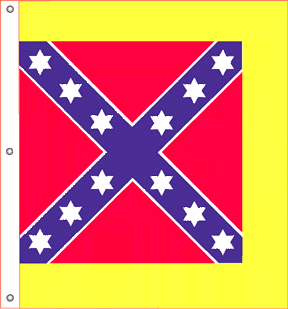
...this battle flag was the Cassidy ANV(Army of Northern Virginia style) battle flag made in New Orleans, by Henry Cassidy, whose business was that of making ship sails and Louisiana flags. This company produced a group of some 30 flags for Bragg's Corps and records indicate that ALL infantry regiments at the Battle of Shiloh in Bragg's Corps had been issued the flag prior to the battle. More than likely the 18th Louisiana did indeed carry this flag onto the field of honor on those fateful days of April 6-7, 1862. You will notice that the flag is almost square in size as opposed to the traditional presentation of a rectangular standard. The only discrepancy is that the yellow border around the flag may have been a pink color as opposed to yellow/gold. This depends on whichever source you check out.
The following notation is a very important point to make with regards to the 1st Cassidy ANV Flag: "...April 7, 1862, 2nd Day of Shiloh...As we were coming into position, William White, of our company, took the flag and carried it forward some 50 or 100 yards ahead of our line in spite of remonstrances, and there placing the flag by his side began firing upon the enemy and remained there until he was severely wounded...April 7th, 1862, 2nd Day of Shiloh...and William White was badly wounded and captured. White had a leg afterwards amputated, died on a steamboat, and was buried at Hawesville, Kentucky..." This passage is from the diary of Silas T. Grisamore, Acting Quartermaster, 18th Louisiana Infantry Regiment, Reminiscences of Uncle Silas, A History of the Eighteenth Louisiana Infantry Regiment, edited by Arthur W. Bergeron, Jr.
For further details on the history of the Confederate flag, check out the following excellent web sites:
Flags of the Confederacy
also
Confederate Flag History
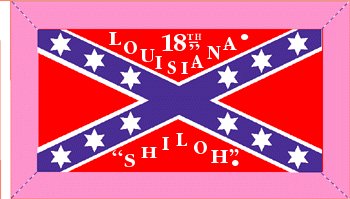
...this battle flag was the 3rd Cassidy ANV(Army of Northern Virginia) battle flag made in New Orleans, by the Henry Cassidy. For information on the 2nd Cassidy ANV flag, see the links below for additional details and information. The flag is the third set created and shipped to the regiments encamped in Corinth following the Battle of Shiloh. The flags were replaced on an "as need" basis, and assuming that the regimental flag was indeed lost on the second day of battle at Shiloh, then it would stand to reason that the "replacement" flag was issued to the 18th Louisiana Infantry Regiment while encamped at Corinth. The border was pink as opposed to yellow/gold. The inscription is speculative and similar in design to one of the Florida regiments. The size is also a change and more in line with the Army of Northern Virgina flag in the rectangular style instead of the previous square pattern. For further details on the history of the Confederate flag, check out the following excellent web sites:
Flags of the Confederacy
also
Confederate Flag History
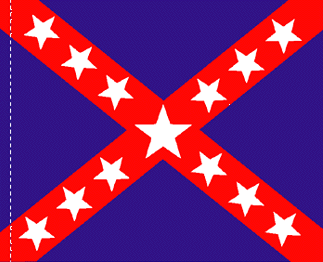
...on 14 November 1863, the 18th Regiment was consolidated with the 10th Louisiana Battalion (Yellow Jacket Battalion) at Simmesport and was redesignated the "Consolidated 18th Louisiana Infantry Regiment and Yellow Jacket Battalion". It should be noted that the colors have been reversed and there is a lack of white border separating the blue and red areas of the flag in this distinctive flag design used by General Richard Taylor's army. During the Red River Campaign, the 18th Louisiana was part of General Richard Taylor's army and served with valor at the Battle of Mansfield in northwestern Louisiana on 8 April 1864. This battle proved to be costly for the 18th Louisiana...approximately 100 men were killed, wounded, taken prisoner or missing in action. Colonel Leopold L. Armant, the regiment's commander was instantly killed during this battle. Even more heart-wrenching, General Alfred Mouton, the beloved brigade commander was killed by a group of federal troops while he attempted to obtain the surrender of that group of which had been cut off by his advancing troops. For further details on the history of the Confederate flag, check out the following excellent web sites:
Flags of the Confederacy
also
Confederate Flag History
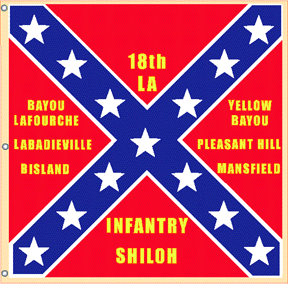
...this flag design is based on a "small torn section of the regimental battle flag" which is currently on display in the Memorial Hall Confederate Museum, New Orleans, Louisiana. May 19, 1865...when the 18th Regiment was disbanded the flag was torn into ten pieces and a piece given to each of the ten company commanders. This tearing up into sections was done so as to forgo the humiliating experience of surrendering the battle flag (colors) to the opposing forces. (Placement of Battle Inscriptions is speculative and based on similar Confederate battle flags of the same period.)

...this flag design is based on a painting which was on display in the Memorial Hall Confederate Museum, New Orleans, Louisiana. The painting is of Col. Leopold Ludger Armant of the 18th Louisiana Infantry Regiment and depicts this flag in the background of the painting. The flag appears to be a variation of the Department of Alabama, Mississippi and East Louisiana battle flag. It is presumed that the family of Col. Armant commissioned the painting. Currently, this painting is being restored due to some water damage incurred from a leaky roof as a result of ongoing construction in and near the current museum location. Many thanks to Mr. Denis Gaubert who provided invaluable collaboration assistance in compiling the image depicted above. For further details on the history of the Confederate flag, check out the following excellent web sites:
Flags of the Confederacy
also
Confederate Flag History
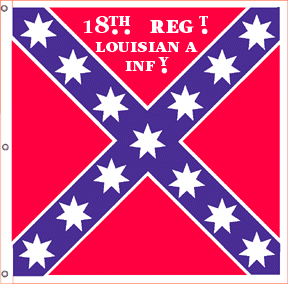
...flag design is based on the regimental colors carried onto the "field of honor", by Co. H., 18th Louisiana Infantry Regiment...a "Living History" unit, based in southwest Louisiana, that participates in Civil War battle reenactments and living history demonstrations throughout the South. The unusual "seven point star" is named the "Bragg Star" after General Braxton Bragg, the 2nd Corps commander at the Battle of Shiloh. It is said, by this living history group, that he (General Braxton Bragg) designed the distinctive star for his battle flags which were carried unto the field of honor at the Battle of Shiloh. This unique star design is a deviation of the The Cassidy ANV Flag depicted above. Interesting variation on a similar theme!
(Information and flag detail is derived from conversations with 1st Sgt. Corey L. Bonin, Co. H., 18th Louisiana Infantry Regiment (Living History unit), and photos taken of the distinctive battle flag at the Reenactment of the Battle of Port Hudson on March 25, 2000)
Image #1. The distinctive "Bragg seven point star" regimental flag of Co. H., 18th Louisiana Infantry Regiment -- a Louisiana Living History Unit.
Image #2 & #3, 1st Sgt. Corey L. Bonin, Co. H.,
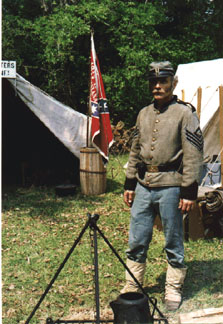
18th Louisiana Infantry Regiment (Living History unit)
pictured at the regimental campsite during the reenactment of the
Battle of Port Hudson, Louisiana on March 25, 2000.
|
|

© Copyright 1997-2006
18th Louisiana Infantry Regiment
All Rights Reserved
|
|
Previous
|
Next |